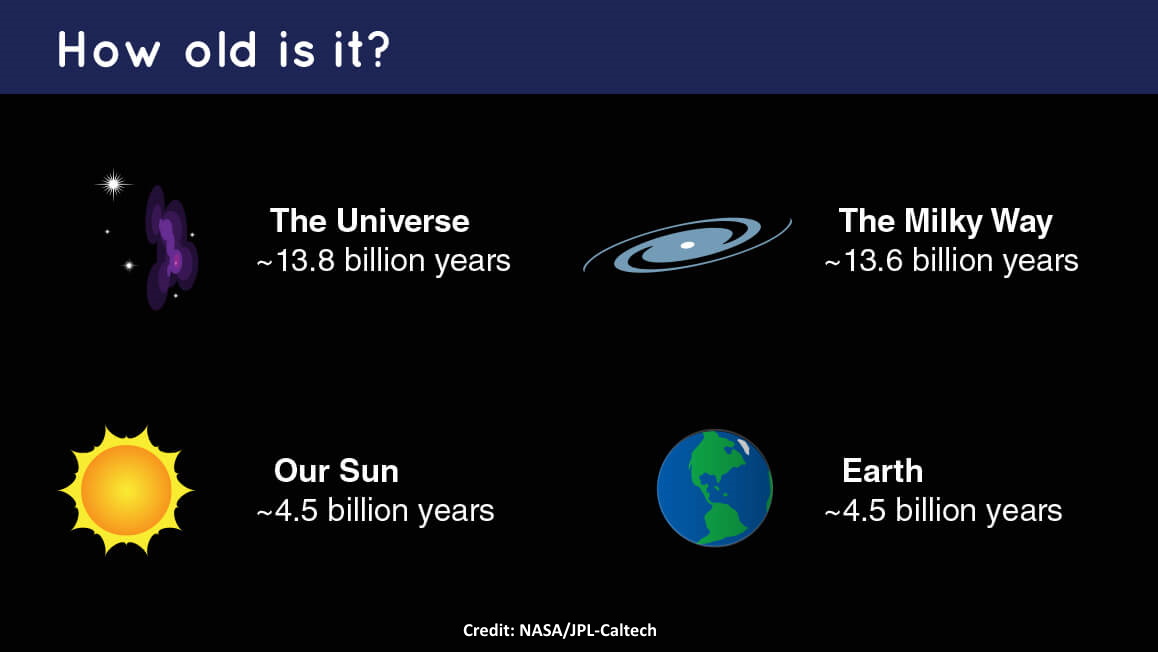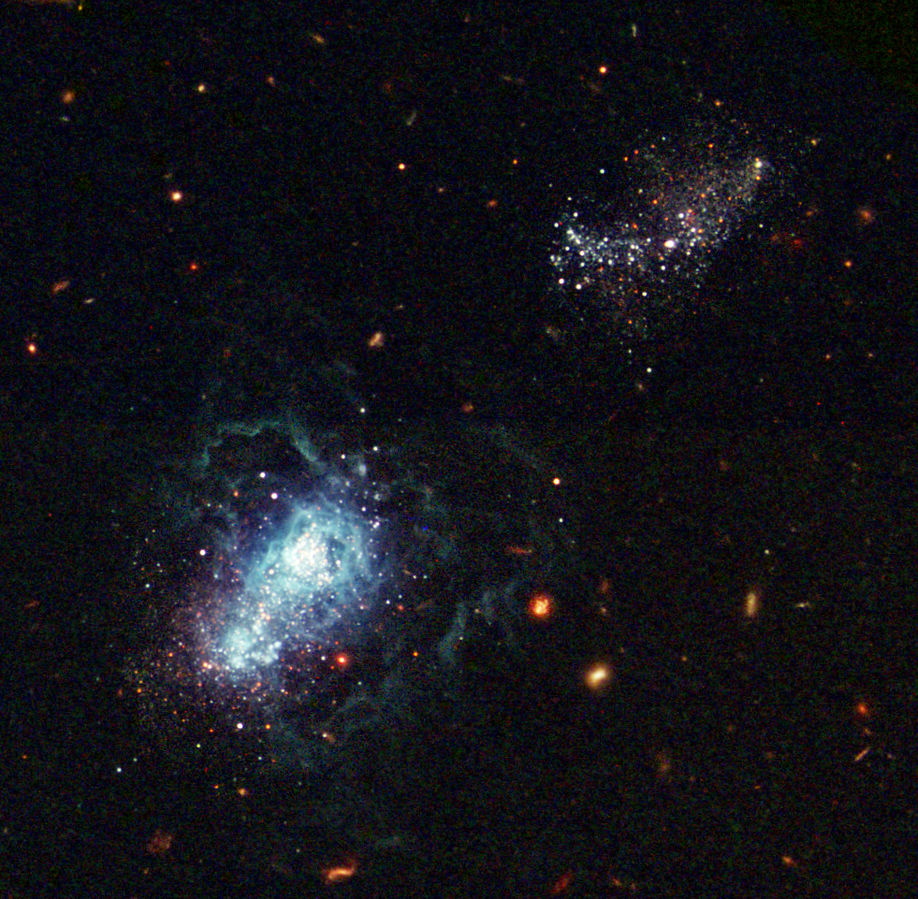Post by 1dave on Oct 31, 2021 10:22:49 GMT -5

Our Earth has existed for 1/3rd of all time!
We calculate that our universe is about 13.8 billion years old. Most galaxies formed between 10 billion and 13.6 billion years ago when the universe was quite young, small, and crowded.
Astronomers believe that our own Milky Way galaxy is approximately 13.6 billion years old. The newest galaxy we know of formed only about 500 million years ago.
I am amazed at how similar the Crab Nebula, an exploding star, is to Centaurus a - an exploding galaxy!
Crab Nebula


Centaurus a

The early universe must have been so compact the first stars were galaxy size and almost immediately exploded to become galaxies with Black Holes at their centers - just as supernovas do today at a much smaller scale!
The youngest known galaxy is 1 Zwicky 18. At an estimated age of a mere 500 million years, it is a babe in diapers compared to the Milky Way at 10-14 billion years, which is the average age of the known galaxies.
en.wikipedia.org/wiki/I_Zwicky_18
I Zwicky 18 is a dwarf irregular galaxy located about 59 million light years away[2] in the constellation Ursa Major. The galaxy was first identified by Swiss astronomer Fritz Zwicky in a 1930s photographic survey of galaxies.[3]
. .. . it remains a mystery why I Zwicky 18 formed so few stars in the past, and why it is forming so many new stars right now.[2]
In 2015 a study found a very large region of ionised helium in this small galaxy, which tends to be more frequent in very distant galaxies with low presence of metals. The ionization of helium implies the presence of objects emitting a radiation intense enough to knock electrons off the helium atoms.[6] Scientists therefore conclude that I Zwicky 18 must contain Population III stars, which are almost absent in all other galaxies in the local universe.[7]

Date 2003- NASA's Hubble Space Telescope snapped a view of what may be the youngest galaxy ever seen. This "late bloomer" may not have begun active star formation until about 13 billion years after the Big Bang.
Called I Zwicky 18 (bottom-left of the image), the galaxy may be as young as 500 million years old. This youngster has gone though several sudden bursts of star formation — the first only some 500 million years ago and the latest only 4 million years ago.
This galaxy is typical of the kinds of galaxies that inhabited the early universe. The galaxy is classified as a dwarf irregular galaxy and is much smaller than our Milky Way.
The two major starburst regions are the concentrated bluish-white knots embedded in the heart of the galaxy. The wispy blue filaments surrounding the central starburst region are bubbles of gas that have been heated by stellar winds and intense ultraviolet radiation unleashed by hot, young stars. The redder stars are slightly older stars and star clusters, but they are still less than 1 billion years old.
A companion galaxy lies just above and to the right of the dwarf galaxy. The companion may be interacting with the dwarf galaxy and may have triggered that galaxy's recent star formation. The red blobs surrounding the dwarf galaxy are the dim glow from ancient fully formed galaxies.
www.universetoday.com/30168/galaxies/
Posted on April 30, 2009 by Fraser Cain
Galaxies
Hello, is there anyone out there? With all of the galaxies in the Universe, is it possible that there is cognizant life somewhere else? Well, I can not answer that question for you, but I can offer you a great deal of information about galaxies so that you can make your own informed decision on the matter.
Our’s is a spiral galaxy. A spiral galaxy is shaped like a flat disk with a thicker bulge in the center. Bright spiral arms start from the center and then coil outward like a pinwheel. All spirals rotate very slowly. The Milky Way completes a single revolution once every 250 million years.
Most galaxies are billions of years old. The youngest known galaxy is 1 Zwicky 18. At an estimated age of a mere 500 million years, it is a babe in diapers compared to the Milky Way at 10-14 billion years, which is the average age of the known galaxies.
Scientists think that galaxy formation was led by dark matter. This invisible material clumped together and it attracted regular mass with its gravity, channeling material together into larger and larger collections. This process of matter accretion led to the first proto-galaxies.
The Canis Major Dwarf Galaxy is the closest galaxy to ours. It is actually contained within the Milky Way and only 42,000 light years form the galactic core.
In the links below you will find thousands of facts, figures, and images that will help you understand many things about galaxies in general and some specific types. Enjoy your reading.
Youngest Galaxy Found
How Do Large Galaxies Form?
Spiral Galaxy NGC 2403
Dark Matter Galaxy
Solar System Galaxy Universe
The Closest Galaxy to the Milky Way
The Diameters of the Milky Way
How Many Stars are in the Milky Way?
How Many Stars are in Galaxies?
How Many Planets are in the Milky Way?
Most Distance Object Ever Seen
Spiral Galaxy
Galaxy Center
Galaxy Pictures
Quasars
Intergalactic Space
Local Group of Galaxies
Andromeda Galaxy
Planets in the Galaxy
How Many Galaxies in the Universe?
Sombrero Galaxy
Elliptical Galaxy
Irregular Galaxy
Galaxy Groups
Whirlpool Galaxy
Galaxy Cluster
Other Galaxies
What is a Galaxy?
Magellanic Clouds
Galaxy Formation
Small Magellanic Cloud
Large Magellanic Cloud
Superclusters
Blazars
Dwarf Galaxies
Galaxy Collision
Virgo Cluster
Virgo Supercluster
Comet Galaxy
Ring Galaxy
What is the Largest Galaxy?
Great Attractor
Galaxy Rotation
Galaxy Evolution
Distance to Andromeda
Active Galactic Nuclei
Galactic Plane
Galactic Equator
Galactic Alignment
How Are Galaxies Named?
Galaxy Core
Starburst Galaxy
Triangulum Galaxy
How Many Galaxies Have We Discovered?
Sagittarius A
Barred Spiral Galaxy
Galaxy Pics
Galaxy Names
Milky Way Galaxy
Centaurus A
What Galaxy is the Earth in?
Spiral Galaxy Pictures
Andromeda Galaxy Pictures
Irregular Galaxy Pictures
Elliptical Galaxy Pictures
Hubble Photos of Galaxies
What is a Quasar?
What is the Name of our Galaxy?
What Galaxy do we Live in?
Triangulum Galaxy M33
Types of Galaxies
Closest Galaxy Discovered
Wallpaper Star Formation in Nearby Galaxy
Starburst Galaxy NGC 1313
Galaxy Shapes











